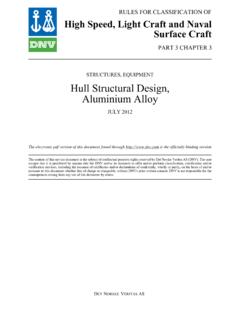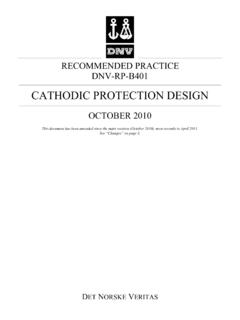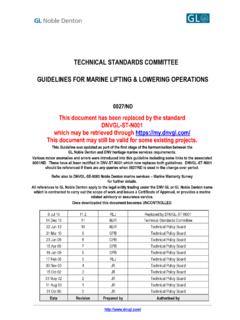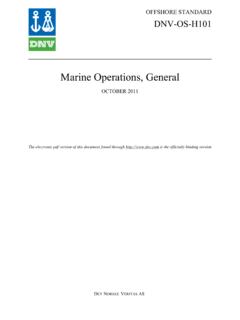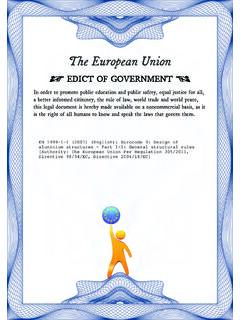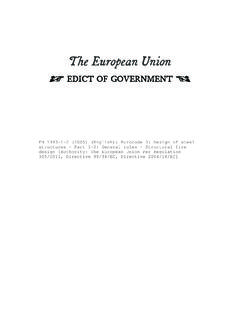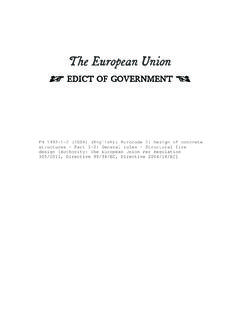Transcription of DNV-OS-J103: Design of Floating Wind Turbine Structures
1 OFFSHORE STANDARD. DNV-OS-J103. Design of Floating wind Turbine Structures JUNE 2013. The electronic pdf version of this document found through is the officially binding version DET NORSKE VERITAS AS. FOREWORD. DNV is a global provider of knowledge for managing risk. Today, safe and responsible business conduct is both a license to operate and a competitive advantage. Our core competence is to identify, assess, and advise on risk management. From our leading position in certification, classification, verification, and training, we develop and apply standards and best practices. This helps our customers safely and responsibly improve their business performance. DNV is an independent organisation with dedicated risk professionals in more than 100 countries, with the purpose of safeguarding life, property and the environment. DNV service documents consist of among others the following types of documents: Service Specifications.
2 Procedural requirements. Standards. Technical requirements. Recommended Practices. Guidance. The Standards and Recommended Practices are offered within the following areas: A) Qualification, Quality and Safety Methodology B) Materials Technology C) Structures D) Systems E) Special Facilities F) Pipelines and Risers G) Asset Operation H) Marine Operations J) Cleaner Energy O) Subsea Systems U) Unconventional Oil & Gas Det Norske Veritas AS June 2013. Any comments may be sent by e-mail to This service document has been prepared based on available knowledge, technology and/or information at the time of issuance of this document, and is believed to reflect the best of contemporary technology. The use of this document by others than DNV is at the user's sole risk. DNV does not accept any liability or responsibility for loss or damages resulting from any use of this document.
3 Offshore Standard DNV-OS-J103, June 2013. Changes Page 3. CHANGES CURRENT. General This is a new document. Acknowledgments The development of this offshore standard was carried out under a Joint Industry Project supported by the following companies: Statoil ASA, Norway Nippon Steel & Sumitomo Metal Corporation, Japan Sasebo Heavy Industries Co., Ltd., Japan STX Offshore & Shipbuilding Co., Ltd., Korea Navantia, , Spain Gamesa, Spain Iberdrola Renovables Energ a , Spain Alstom wind , Spain The Glosten Associates, Inc., Principle Power Inc., This support is gratefully acknowledged. DET NORSKE VERITAS AS. Offshore Standard DNV-OS-J103, June 2013. Contents Page 4. CONTENTS. SEC. 1 INTRODUCTION .. 10. 1 10. Objectives .. 10. Scope and application .. 11. Non-DNV codes .. 11. Equivalence and future developments .. 11. Hierarchy of DNV Offshore Publications.
4 12. 2 12. 3 Verbal forms .. 14. Terms .. 14. 4 Acronyms, Abbreviations and Acronyms and abbreviations .. 16. Symbols .. 17. 5 Typical Floaters and Boundary Conditions ..19. 19. SEC. 2 SAFETY PHILOSOPHY AND Design PRINCIPLES .. 21. 1 21. Application .. 21. 2 Safety Philosophy ..21. Safety class methodology .. 21. Target safety .. 22. Robustness .. 22. 3 Design Principles and Design Conditions ..22. Methods for structural Design .. 22. Aim of the 22. Design conditions .. 22. 4 Limit 23. 5 Design by the Partial Safety Factor Method ..23. 23. The partial safety factor format .. 24. Characteristic load effect .. 26. Characteristic resistance .. 26. Load and resistance 26. 6 Design Assisted by Testing ..26. 26. Model 26. Full-scale testing and observation of performance of existing Structures .. 26. 7 Probability-Based Design ..27. 27.
5 SEC. 3 ENVIRONMENTAL 28. 1 28. 2 wind , Waves and Current ..29. 29. wind .. 29. Waves .. 31. Current .. 32. 3 Water Depth and Water Water 32. Water 32. 4 Seismicity ..33. 33. 5 Soil Conditions ..33. 33. DET NORSKE VERITAS AS. Offshore Standard DNV-OS-J103, June 2013. Contents Page 5. 6 Regional Environmental Data for Definition of Environmental 34. 7 Other Site Conditions ..35. 35. 35. Marine growth .. 35. SEC. 4 LOADS AND LOAD EFFECTS .. 36. 1 36. Extreme loads .. 36. Fatigue 36. Transportation loads .. 36. wind Turbine 36. Wake-induced 36. 2 Response 37. Deep-draught floaters (DDFs) .. 37. Semisubmersibles .. 37. Tension-leg platforms (TLPs).. 37. Monohull Structures .. 37. 3 Basis for Definition of Characteristic Loads ..38. Load categorization .. 38. Definition of characteristic 38. 4 Permanent Loads (G) ..40. 40. Floater-specific 40.
6 5 Variable Functional Loads (Q) ..40. 40. Ship impacts and collisions .. 40. 6 Environmental Loads (E) ..41. 41. Floater-specific 41. Design load 42. Ice loads .. 42. Fatigue 42. 7 Accidental Loads (A) ..42. 42. 8 Deformation Loads (D)..43. 43. 9 Pressure Loads on Hull ..43. 43. Tank pressures .. 43. Sea pressures for the 45. Combination of tank pressures and sea 46. Superimposition of responses .. 46. Wave slamming .. 47. SEC. 5 LOAD FACTORS AND MATERIAL 48. 1 Load Load factors for the ULS and the ALS .. 48. Load factor for the FLS .. 48. Load factor for the SLS .. 49. 2 Material Material factors for the 49. Material factors for the FLS .. 49. Material factors for the ALS and the SLS .. 49. SEC. 6 50. 1 50. 2 Selection of Metallic Materials ..50. 50. Structural steel and aluminium .. 50. Bolting 50. DET NORSKE VERITAS AS. Offshore Standard DNV-OS-J103, June 2013.
7 Contents Page 6. 3 Selection of Concrete 50. 4 Selection of Grout Materials ..51. 51. 5 Selection of Composite Materials ..51. 51. 6 Selection of Materials for Chains, Wires and 51. Chains .. 51. Steel 51. Fibre ropes .. 51. 7 Selection of Materials for Electrical Cables ..52. 52. 8 Selection of Materials for Solid 52. SEC. 7 STRUCTURAL Design .. 53. 1 53. Interface with wind 53. Design against undesirable 53. Installation-friendly 54. Special provisions for global analysis .. 54. Special provisions for 54. Special provisions for 56. Special provisions for spars .. 57. Provisions for concrete 57. Special provisions for 57. 2 Ultimate Limit States (ULS) for Steel Structures ..57. 57. ULS Tubular members, tubular joints and conical transitions .. 57. ULS Shell Structures .. 58. ULS Non-tubular beams, columns and 58. ULS Special provisions for plating, stiffeners and 58.
8 ULS Special provisions for structural Design of anchors .. 58. ULS Bolted connections .. 59. 3 Fatigue Limit States (FLS) for Steel 59. 4 Accidental Limit States (ALS) ..61. 61. Post-accidental integrity after unintended change in ballast 62. Post-accidental integrity of a shared anchor .. 62. SEC. 8 STATION 63. 1 63. Compliant floaters 63. Restrained floaters general .. 64. 2 Mooring Lines ..64. 64. Ultimate 64. Resistance .. 65. Design criterion .. 66. Fatigue 66. 3 Steel 67. Fibre rope tendons .. 67. Tendon slack .. 67. SEC. 9 Design OF ANCHOR 69. 1 69. Anchor load .. 69. Anchor 70. Design criterion .. 70. Effects of cyclic loading .. 70. DET NORSKE VERITAS AS. Offshore Standard DNV-OS-J103, June 2013. Contents Page 7. 2 Pile 71. Material 71. Anchors in chalk .. 71. 3 Gravity 71. Material 72. 4 Suction Anchors in 72. Material 73.
9 5 Free-Fall Anchors in Clay ..73. 73. Material 74. 6 Fluke Anchors in Clay ..74. 74. Material 75. 7 Plate Anchors in Clay ..75. 75. Material 75. 8 Grouted Rock 75. SEC. 10 Floating STABILITY .. 78. 1 General 78. 2 Intact General .. 80. Ship-shaped Structures .. 80. Column-stabilized Structures .. 81. Deep Draught Floaters (DDFs).. 81. Tension Leg Platforms (TLPs) .. 81. 3 Damaged 81. Ship-shaped Structures .. 82. Column-stabilized Structures .. 82. Deep Draught Floaters (DDFs).. 83. Tension Leg Platforms (TLPs) .. 83. Extent of damage .. 84. 4 Watertight General 84. External openings .. 84. Internal openings .. 84. Capacity of watertight doors and hatch covers; operation and control .. 84. Load 84. SEC. 11 CONTROL SYSTEM .. 85. 1 85. 2 Floater Motion Control ..85. 85. Floater motion controller .. 85. Effect of floater motion control.
10 86. 3 Special Issues ..86. Interaction with other systems .. 86. SEC. 12 ELECTRICAL AND MECHANICAL SYSTEMS .. 87. 1 87. 2 Mechanical Systems ..87. 87. Bilge 87. Ballast system .. 87. Compartment venting .. 87. Mooring equipment .. 87. Cranes .. 87. DET NORSKE VERITAS AS. Offshore Standard DNV-OS-J103, June 2013. Contents Page 8. Installation systems and pull-in 87. Turret 87. Power generation 88. Fire fighting systems and 88. Other equipment .. 88. 3 Electrical Systems ..88. Lightning and earthing 88. SEC. 13 CORROSION 89. 1 89. Splash zone .. 89. Other 89. SEC. 14 TRANSPORT AND INSTALLATION .. 91. 1 Marine 91. 2 Risk Management during Marine Operations ..91. Risk management in transportation and installation phases .. 91. 3 Marine Warranty Surveys ..91. 91. 4 Marine Operations General Requirements ..91. 91. 5 Marine Operations Specific Requirements.
